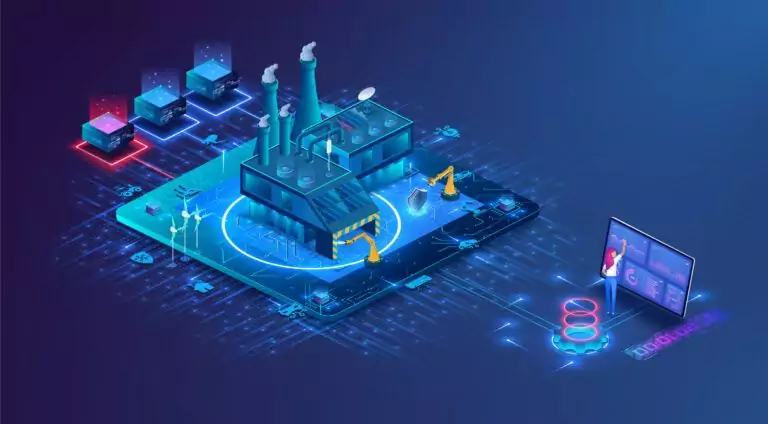This article describes 3 components of digital transformation. As digital transformation is a broad topic, we’ve highlighted common core components and looked at how they apply to industrial assets and project teams.
The phrase digital transformation has been around for years.
Google Trends shows search data as far back as 2004 with a steady increase beginning in 2015.
Intro to Digital Transformation
In 2011, Capgemini Consulting and the MIT Center for Digital Business conducted a digital transformation study. A few years ahead of the curve, the study intended to be a digital transformation road map for large enterprises.
Digital transformation initiatives have since become mainstream. The International Data Corporation (IDC) predicts transformation spending will be in the trillions.
It doesn’t matter what industry you’re in. Companies from retail and hospitality to health care and energy are embracing new digital strategies and business models.
But how can business executives digitally transform their operations and limit the risks associated with any major shift?
After all, there is no future-proofing business. The digital age moves too fast.
By going digital, companies can become more nimble and set the business strategy for continued growth. It is the only way to compete with newer businesses that were “born digital.” Organizations need to transform, or they will fall behind and ultimately fail.
To digitally transform your business, however, you need to understand what digital transformation means and exactly what the process entails. For heavy infrastructure owners, it is crucial to understand the main 3 components of digital transformation for industrial assets.
When an asset’s total installation costThe total installed cost refers to the final cost of designing, fabricating and building a capital project or industrial asset. Various phas… (TIC) is in the billions, even the smallest errors are costly. Conversely, micro-efficiency improvements might be able to reduce TIC by millions.

What is Digital Transformation?
The Capgemini-MIT report defined digital transformation as “the use of technology to radically improve performance or reach of enterprises.”
The study found that executives were “using digital advances such as analytics, mobility, social media, and smart embedded devices.” They did this while improving their use of data already at hand to:
- change the customer experience
- disrupt internal processes
- increase value propositions
In other words, these executives were making foundational changes to how their organization conducted business to increase their revenue. They were able to deliver a better experience to their customers by harnessing change using digital innovation and technology.
Digital transformation goes beyond modernizing processes and using the cloud. It embraces the “future of culture,” enabling empathy and empowerment alongside innovation, artificial intelligence, and big data.
The Main 3 Components of Digital Transformation
There are 3 main components of digital transformation:Recreating your internal processes
Transforming your technology
Overhauling your relationships
Infrastructure changes should enable new processes that help you keep pace with your market’s long-term needs.
When thinking about the needs of your market, you should be thinking about the needs of your:
- employees
- business partners
- customer or clients
We define digital transformation as the implementation of digital technology to fundamentally transform areas of your assets and bring value to stakeholders.
An effective digital transformation strategy incorporates a culture of innovation, empowerment, and change.
1) Recreate Your Internal Processes
Some asset owners and engineering companies still use outmoded internal processes.
Overhauling your process means more than just embracing unified communications and the cloud, however. To recreate your internal process, you must implement technology that enhances the way you do business and improves the experience for everyone.
Digital industrial transformation does not mean using a modern technique to keep doing the same thing. Rather, it should consider how an entirely new process might benefit your business.
Take data-centricA data-centric outlook is a core concept in digital project execution architecture where data is viewed as the most important and perpetual … architecture, for example.
Many large enterprises rely on document-based deliverables produced throughout the life of the project. These documents transfer knowledge between disciplines, phases, the client, future engineering firms, and other vendors.
The problem with a document-based approach is that every change leads to a…
- new deliverable, which triggers…
- new change order, which triggers…
- new set of documentation, which creates…
- higher chance of data discordance.
This change process is slow and complicated, leading to data silos and misaligned delivery expectations. Data dissonance increases the chances of slipped delivery dates and budget overruns.
A data-centric methodology revolves around a single source of truthSingle source of truth (SSOT) refers to the practice of structuring information models and associated data schema such that every data ele… (SSOT). The SSOT acts as a central location where all project information is stored and maintained.
Current data becomes available in real-time to all personnel on the project. This eliminates data discordance and provides decision-makers with on-demand access to accurate and verifiable project data.
Data-centric architecture with a single source of truth transforms engineering projects, resulting in enhanced productivity and significant savings.
2) Overhaul Your Technology
As with the changes in your internal processes, the changes you make to your technology must be transformational.
By digitalizing operations, business leaders can remove barriers and react more efficiently to market changes. Embracing the cloud, adopting AI, and welcoming big data are all going to be critical to helping you to keep pace.
For example, Vista’s system integration consultants create digital engineering environments that last for the entire life cycle of your asset.
Our single-source-of-truth environment is the foundation of our truth-based industrial engineering approach. This customized digital project execution model that places transparency, collaboration, and quality at the center of how we operate.
3) Increase the Quality of Your Customer Relations
The third pillar of digital transformation is to improve your customer experience. It is important to note here that your customer is anyone to which you provide services or interact with on projects.
On industrial assets, we think of customers as stakeholders. Industrial assets have many stakeholder groups including clients, staff, and vendors. These groups comprise:
- Engineers
- Technicians
- Project managers
- Support services
The goal of overhauling your customer’s user experience is to increase the value of your interactions. For some companies, that means enhancing automation. For others, digital transformation may mean using AI or machine learning.
By embracing a digital project executionDigital project execution (DPE) is a project management methodology that uses a data-centric approach to reduce project total-install-cost a… model, we transformed our integrated engineeringThe process of integrated engineering involves multiple engineering disciplines working in conjunction with other project disciplines to e… services. This involved giving our teams the right tools and the proper processes to succeed. The result is that Vista’s clients are able to better harness the broad, combined knowledge of our engineering specialists.

Benefits of Digital Transformation
The 3 components of digital transformation involve the adoption of digital technology to fuel fundamental change in your organization.
As discussed, the primary goal is to increase the value of your interactions with your customers. There are several other benefits to digital transformation. Let’s explore.
Businesses save money by going digital. It’s easy to think of savings related to printing and distribution compared to digital communication and storage.
Industrial asset development certainly produces a significant amount of paper under a traditional execution model. But with large capital projects, the printing-related savings from a digital execution architecture are a drop in the bucket.
The major cost-saving areas realized through digital transformation include:
- Reduced errors
- Increased efficiency
- Easier collaboration
- Improved innovation
Digital Transformation Strategy
Creating a strategy to implement the 3 components of digital transformation is essential.
Having a partner who is well-versed in the pitfalls of the transformative process can help your process. The guidance of an experienced partner will help you avoid mistakes and benefit from the advantages.
Vista Projects has been simplifying digital transformations with our single-source-of-truth technology since 2014. We are focused on digitally transforming assets for the global energy and industrial markets.
Our experienced team is here to help digitally transform your assets.
Looking for help with your digital industrial transformation? One of Vista’s digital transformation experts would be happy to discuss your challenges.
Digital Transformation FAQ
- Business Process – this is the transformation of business processes, services, and models a company uses by introducing technology that can leverage the skills, successes, and opportunities of its team.
- Business Model – business model involves incorporating technology because it will drive revenue and improve the customer experience, rather than just implementing technology for technology’s sake.
- Domain – domain transformations involve a business being able to slide into another area successfully.
- Cultural/ Organizational – organizational transformation involves getting everybody to a common agreement and acceptance of big changes.
- Proof of Digital Success – this approach exercises a skeptical eye towards digital efforts. This helps organizations that focus on empirical results and are risk-averse in nature.
- Full Digital Strategy Development – this approach concentrates on getting the strategy right and as complete as possible beforehand. It focuses on cultural change and implementation in a rapid and agile fashion.
- Gradual Increment Delivery to Digital Dexterity – this approach involves small rewards for every potential changing digital destination.










